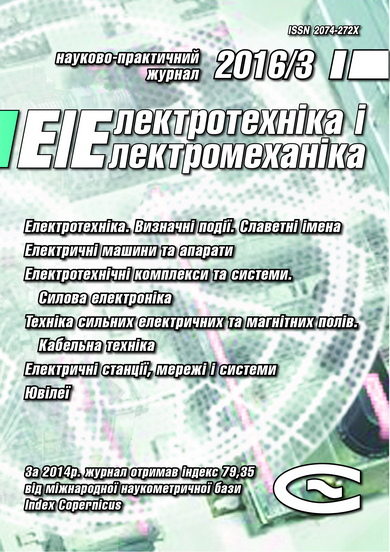A METHOD FOR DETERMINING LOCATION OF VOLTAGE FLUCTUATIONS SOURCE IN ELECTRIC GRID
DOI:
https://doi.org/10.20998/2074-272X.2016.3.09Keywords:
quality of the electric power, indicators of quality of the electric power, fluctuation of voltage, source of fluctuation of voltage, curve of change of voltage, curve of change of active power, definition of responsibilityAbstract
Purpose. The purpose of work is development of a method of definition of the location of a source of fluctuations of voltage. Methodology. The reasons of emergence of fluctuations of voltage at an arrangement of a source both in power lines, and in the consumer's networks, are connected with changes of consumption and active and reactive capacities. As criterion for definition of the location of a source of fluctuations of voltage we choose change of size of the active power received by reception substation on equivalent communication with system. The source of fluctuations of voltage is external for the consumer if emergence of fluctuations of voltage leads to the coordinated changes of tension and consumed in the area of active power that corresponds to a condition of the positive regulating effect of active loading on voltage (1). The source of fluctuations of voltage is internal for the consumer if emergence of fluctuations of voltage leads to counter changes of tension and consumed in the area of active power that resembles a condition of the negative regulating effect of active loading on voltage superficially (6). Results. The method of definition of the location of a source of fluctuations of voltage in an electric network which, works by the principle of an assessment of correlation of change of power and tension in a power supply network is developed. The method allows to consider shift between extrema of curves of change of voltage of U(t) and power of Pload(t). Originality. The method of definition of an arrangement of a source of fluctuations of voltage is developed. Practical value. The answer to this question where the source of fluctuations of voltage (in the territory of the consumer is located or in an external network) confirmed with the determined calculation, can form a basis of the expert opinion for the solution of legal disputes at an assessment of the damages caused by poor quality of electric energy.References
1. GOST 13109-97. Elektricheskaya energiya. Sovmestimost' tehnicheskih sredstv elektromagnitnaya. Normy kachestva elektricheskoi energii v sistemah elektrosnabzheniya obschego naznacheniya [State Standard 13109-97. Electrical energy. Technical equipment electromagnetic compatibility. Quality standards for electrical energy in general use power systems]. Minsk, IPK Publishing house of standards, 1998. 30 p. (Rus).
2. Idelchik V.I. Elektricheskie sistemy i seti: Uchebnik dlia vuzov [Electrical Systems and Grids: Textbook for high schools]. Moscow, Energoatomisdat Publ., 1989. 592 p. (Rus).
3. Venikov V.A. Perekhodnye elektromekhanicheskie protsessy v elektricheskikh sistemakh: Ucheb. dlia elektroenerget. spets. vuzov [Transitional electromechanical processes in electrical systems: Textbook for electric. specialist. high schools]. Moscow, High School Publ., 1985. 536 p. (Rus).
4. Bronshteyn I.N., Semendyayev K.A. Spravochnik po matematike dlya inzhenerov i uchashchikhsya vuzov [Mathematical handbook for engineers and university students]. Moscow, Nauka Publ., 1986. 723 p. (Rus).
5. Senderovich G.A., Diachenko A.V. The relevance of determining responsibility for violation of power quality in terms of voltage fluctuations. Elektrotekhnіka і elektromekhanіka − Electrical engineering & electromechanics, 2016, no.2, pp. 54-60. (Rus). doi: 10.20998/2074-272X.2016.2.10.
Downloads
Published
How to Cite
Issue
Section
License
Copyright (c) 2016 G. A. Senderovich, A. V. Diachenko

This work is licensed under a Creative Commons Attribution-NonCommercial 4.0 International License.
Authors who publish with this journal agree to the following terms:
1. Authors retain copyright and grant the journal right of first publication with the work simultaneously licensed under a Creative Commons Attribution License that allows others to share the work with an acknowledgement of the work's authorship and initial publication in this journal.
2. Authors are able to enter into separate, additional contractual arrangements for the non-exclusive distribution of the journal's published version of the work (e.g., post it to an institutional repository or publish it in a book), with an acknowledgement of its initial publication in this journal.
3. Authors are permitted and encouraged to post their work online (e.g., in institutional repositories or on their website) prior to and during the submission process, as it can lead to productive exchanges, as well as earlier and greater citation of published work.





